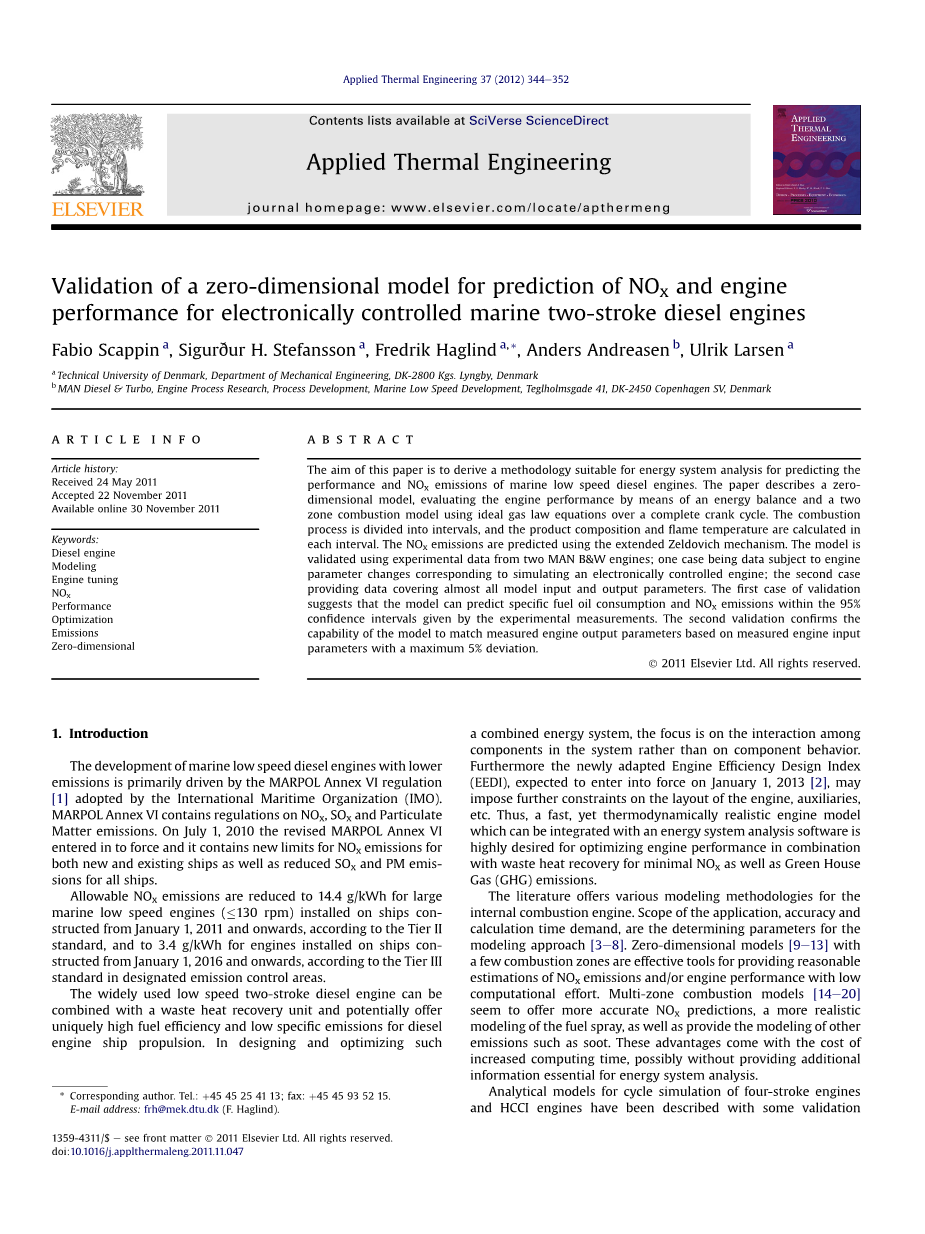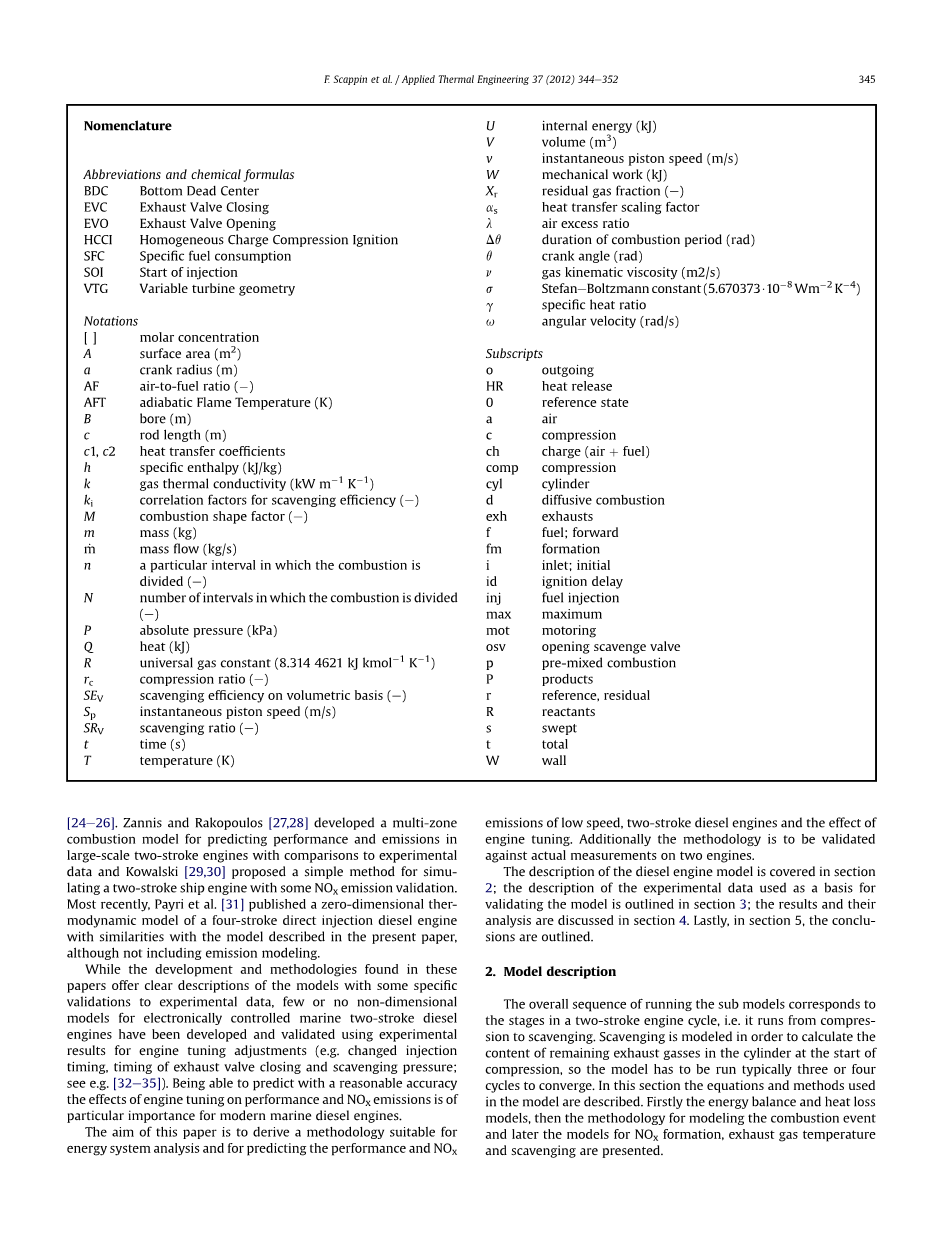

英语原文共 9 页,剩余内容已隐藏,支付完成后下载完整资料
Validation of a zero-dimensional model for prediction of NOx and engine performance for electronically controlled marine two-stroke diesel engines
验证用于预测船用二冲程电控柴油机NOx和发动机性能的零维模型
Fabio Scappina, Sigureth;ur H. Stefanssona, Fredrik Haglinda, Anders Andreasenb, Ulrik Larsena
Abstract
摘要
The aim of this paper is to derive a methodology suitable for energy system
analysis for predicting the performance and NOx emissions of marine low speed diesel engines.
这篇论文的目的是获得一个适合于能源系统分析的方法去预测船用低速柴油机的性能和NOx的排放。
The paper describes a zero-dimensional model, evaluating the engine performance by means of an energy balance and a two zone combustion model using ideal gas law equations over a complete crank cycle.
论文描述了一个通过利用完整曲柄周期的理想气体方程的能量平衡和2个区域燃烧模型来评估发动机性能的零维模型。
The combustion process is divided into intervals, and the product composition and flame temperature are calculated in each interval.
燃烧过程被划分为数个时间区段,并且计算出每个时间段的生成物和火焰温度。
The NOx emissions are predicted using the extended Zeldovich mechanism.
通过使用扩展的Zeldovich机制来预测NOx 的排放。
The model is validated using experimental data from two MAN Bamp;W engines;
该模型使用来自两个MAN B&W发动机的实验数据进行验证。
one case being data subject to engine parameter changes corresponding to simulating an electronically controlled engine;
一种情况下数据服从于与模拟电控发动机相一致的柴油机参数变化;
the second case providing data covering almost all model input and output parameters.
第二种情况提供数据涵盖了几乎所有的输入输出模型。
The first case of validation suggests that the model can predict specific fuel oil consumption and NOx emissions within the 95% confidence intervals given by the experimental measurements.
验证的第一个事例表明与所给的实验测量相比,模型能够预测燃油消耗率和NOx排放在95%的置信区间内。
The second validation confirms the capability of the model to match measured engine output parameters based on measured engine input parameters with a maximum 5% deviation.
第二个验证证实了模型在基于最大偏差为5%的测量的发动机输入参数能够匹配测量的发动机输出参数的能力。
Highlights
亮点
► A fast realistic model of a marine two-stroke low speed diesel engine was derived.
得到了一种船用二冲程低速柴油发动机的快速现实的模型。
► The model is fast and accurate enough for future complex energy systems analysis.
该模型是快速和准确的,足以进行复杂的能源系统分析。
► The effects of engine tuning were validated with experimental tests.
发动机的协调性是通过实验测试验证。
► The model was validated while constrained by experimental input and output data.
在实验的输入输出数据是被约束的时候,模型进行了验证。
Keywords
关键字
Diesel engine; Modeling; Engine tuning; NOx; Performance; Optimization;
Emissions;Zero-dimensional
柴油机;模型;发动机调整;NOx;性能;最佳化;排放;零维模型;
Nomenclature
命名
Abbreviations and chemical formulas
缩写和化学式
BDC
Bottom Dead Center(下止点)
EVC
Exhaust Valve Closing(排气阀闭合)
EVO
Exhaust Valve Opening(排气阀打开)
HCCI
Homogeneous Charge Compression Ignition(均质压燃)
SFC
Specific fuel consumption(燃油消耗率)
SOI
Start of injection(启喷)
VTG
Variable turbine geometry(变几何涡轮)
Notations(符号)
[ ]
molar concentration(体积摩尔浓度)
A
surface area (m2)(表面积)
a
crank radius (m)(曲臂)
AF
air-to-fuel ratio (minus;)(空燃比)
AFT
adiabatic Flame Temperature (K)(绝热燃烧温度)
B
bore (m)(缸径)
c
rod length (m)(连杆长度)
c1, c2
heat transfer coefficients(传热系数)
h
specific enthalpy (kJ/kg)(比焓)
k
gas thermal conductivity (kW mminus;1 Kminus;1)(气体导热系数)
ki
correlation factors for scavenging efficiency (–)(扫气因子)
M
combustion shape factor (–)(燃烧形状因子)
m
mass (kg)(质量)
mass flow (kg/s)(质量流量)
n
a particular interval in which the combustion is divided (–)( 燃烧被分割的特定间隔)
N
number of intervals in which the combustion is divided (–)(燃烧划分的时间间隔数)
P
absolute pressure (kPa)(绝对压力)
Q
heat (kJ)(热量)
R
universal gas constant (8.314 4621 kJ kmolminus;1 Kminus;1)(通用气体常数)
rc
compression ratio (–)(压缩比)
SEV
scavenging efficiency on volumetric basis (–)(基于体积的清除效率)lt;
全文共53102字,剩余内容已隐藏,支付完成后下载完整资料
资料编号:[144957],资料为PDF文档或Word文档,PDF文档可免费转换为Word


